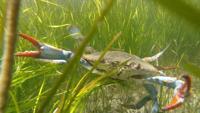CAMBRIDGE, MD - Environmentalists and watermen are optimistic about the health of the Chesapeake Bay following a report indicating an increase in bay grasses.
Scientists at the Virginia Institute of Marine Science have reported a 7% increase in bay grasses compared to last year, a notable improvement from the data reported in 2019. According to Allison Colden, Maryland executive director of the Chesapeake Bay Foundation, the significant decrease in bay grasses in 2019 was due to record rainfall in 2018, which washed a tremendous amount of sediment pollution into the bay. She says reducing stormwater runoff in both urban and rural areas is a main reason for the improved health of the bay grasses.
"Our bay grasses can be resilient over time and recover, but most importantly, they can recover when we reduce the amount of sediment and pollution reaching the bay," says Colden.
The resurgence of bay grasses not only signals a cleaner bay now but also promises a healthier ecosystem for the future. Bay grasses provide crucial hiding places for creatures like crabs, clams, and oysters, protecting them from predators. This development is also good news for local businesses.
"Crabs seem to have more predators these days. We're seeing a lot of catfish," said Joe Brooks, co-owner of J.M. Clayton Seafood. "Hopefully, it transfers to a healthier crab population in the months and years to come."
Despite this positive development, the Chesapeake Bay Foundation acknowledges that there is still much work to be done. "This year's numbers were just over 82,000 acres, but our bay-wide goal for bay grasses is 185,000 acres," Colden noted.
The annual underwater grass survey, conducted by the Virginia Institute of Marine Science between May and November 2023, indicates that while data falls short of the bay-wide goal, airspace restrictions prevented complete surveys. Officials believe that had these areas been fully mapped, Maryland's data would have been higher.
As efforts continue to reduce pollution and support the recovery of bay grasses, the future of the Chesapeake Bay underwater grasses looks greener and more promising.
For the full report click here.


